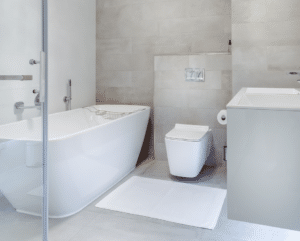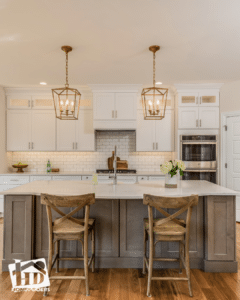A well-ventilated bathroom plays an essential role in maintaining a healthy and comfortable living environment. It reduces the risk of mold growth, keeps humidity levels in check, and helps to eliminate odors. However, not all bathroom venting is created equal, and incorrect venting can lead to a slew of problems. This article aims to enlighten readers about the significance of proper bathroom exhaust venting, familiarize them with common challenges, and provide insights into the Minnesota and Minneapolis venting codes.
The Purpose of Bathroom Venting
Venting a bathroom effectively is more than just ensuring it remains odor-free. Every time you take a hot shower or bath, you’re introducing moisture into the environment. In a closed space like a bathroom, this moisture can quickly lead to high humidity levels. Over time, excessive humidity can cause peeling paint, warped cabinets, and even mold growth, which poses significant health risks.
Common Bathroom Venting Challenges
There are a myriad of issues that can arise from inadequate bathroom venting:
1. No Venting: A bathroom without any form of ventilation is essentially a moisture trap. Beyond the obvious issue of foggy mirrors, it can accelerate the deterioration of bathroom fixtures and materials. This confined moisture can also be a breeding ground for mold, mildew, and bacteria, which can lead to health risks over time.
2. Venting Bathroom into Attic: Opting to vent a bathroom exhaust fan directly into the attic might seem like a quick solution, but it merely transfers the problem from one location to another. In cold climates, especially, the warm, moist air meeting the colder attic air can lead to condensation, which may cause mold growth, wood rot, and even compromise insulation effectiveness.
3. Venting a Basement Bathroom: Basement bathrooms inherently come with their set of challenges due to their sub-ground location. Properly venting them requires additional considerations like longer duct runs, potential backdraft issues, and ensuring pests can’t access the home through the vent.
4. Venting a Bathroom Fan Through the Roof: Although a legitimate venting option, there are associated challenges. The vent’s positioning on the roof is crucial; too close to the roof’s peak can cause moisture to be trapped under roof caps. Additionally, venting in regions prone to snow can result in blockages, inhibiting the fan’s effectiveness.
5. Improper Duct Sizing: The size of the duct plays a pivotal role in effective venting. A duct that’s too small can strain the exhaust fan, reducing its lifespan and efficiency. On the other hand, a duct that’s excessively large can reduce the speed of the expelled air, causing moisture to settle within the duct, potentially leading to mold growth.
6. Duct Length and Bends: A direct route to the outside is ideal, but this isn’t always feasible. The longer the duct and the more bends it has, the harder the fan has to work. Each bend in the duct effectively reduces the fan’s efficiency, potentially leading to inadequate ventilation.
7. Backdraft Issues: Especially in tightly sealed homes, exhaust fans can sometimes cause backdrafting from combustion appliances like furnaces or water heaters. This means that instead of harmful gases venting outside, they’re pulled back into the home, posing significant health risks.
8. Inadequate CFM Ratings: The capacity of bathroom exhaust fans is measured in Cubic Feet per Minute (CFM). A fan with a CFM rating that’s too low for the bathroom’s size won’t effectively remove moisture and odors. It’s crucial to ensure the fan is rated appropriately for the space it’s intended to serve.
Understanding these common challenges underscores the significance of well-thought-out bathroom ventilation. It’s not merely about installing a fan and a duct but ensuring that the entire system works harmoniously to serve its purpose effectively.
Minnesota and Minneapolis Venting Codes
Minnesota has set forth regulations that uphold the integrity of building practices, and this includes bathroom venting. While these rules offer a general framework, Minneapolis, being a large city, may have its additional requirements. Here’s a brief overview:
Ventilation codes in Minnesota are grounded in a commitment to safety, health, and durability. The importance of bathroom venting is particularly emphasized in the state’s regulations. Minneapolis, being one of its bustling cities, has tailored some of these guidelines to cater to the specific needs of its residents. Delving deeper into the details:
● Direct Venting: In alignment with best practices, Minnesota mandates that all bathroom exhaust fans must vent directly to the outdoors. This stipulation is rooted in the understanding that venting into an enclosed space like an attic or a crawl space can cause moisture buildup, leading to mold growth and structural damage. Minneapolis regulations echo these sentiments, ensuring that even in the heart of the city, homes are safeguarded against such issues.
● Venting Distance from Openings: Minnesota codes specify a minimum distance that the exhaust vent must maintain from any openable window or intake vent. This distance ensures that moist air doesn’t recycle back into the home, causing potential humidity issues. Minneapolis codes may vary slightly, especially in dense residential areas, to account for the proximity of buildings.
● Duct Material & Insulation: The state has set parameters on the type of duct material permissible for bathroom venting. Primarily, it should be durable, non-combustible, and resistant to
moisture. Furthermore, in regions susceptible to colder temperatures, ducts must be insulated to avert condensation within, which can degrade the duct’s efficiency and lifespan.
● Basement Venting: Basement bathrooms can present unique challenges due to their below-ground positioning. Minnesota codes stipulate that venting for such bathrooms must be adequately sloped to prevent any water or condensate pooling. Vents must also have a secure termination outside the building, ensuring they’re not expelling moist air into a confined space or near an intake vent.
● Roof Venting: While venting a bathroom fan through the roof is a legitimate method, both Minnesota and Minneapolis have precise criteria to be followed. There’s a need to ensure that the vent protrudes at a suitable height above the roof surface, preventing snow accumulation from blocking it. Proper roof caps, ideally ones with a damper system, should be used. Additionally, it’s crucial to waterproof the vent area, using suitable flashing and sealants, to prevent any water ingress.
For Minneapolis dwellers, while the state’s guidelines provide a foundation, it’s vital to consult with the city’s building department. Given the city’s specific challenges, such as its dense architecture and varying building designs, some additional stipulations or adjustments might be in place.
Residents of Minneapolis are advised to double-check with local regulations as cities often update their codes, and there might be unique stipulations pertinent to the local climate and building practices.
Ensuring Compliance
While understanding the codes is crucial, actual implementation requires expertise. And this is where Honey-Doers come in. Our seasoned professionals have an in-depth understanding of Minnesota’s building codes and Minneapolis’ local requirements. But beyond the technical know-how, we bring warmth and pragmatism to every project. We recognize that every home has unique needs, and our team is adept at tailoring solutions to fit these intricacies.
Conclusion
The essence of bathroom venting is to ensure comfort, health, and the longevity of your home’s components. By acquainting yourself with the common challenges and the prevailing codes, you’re taking a vital step in ensuring your bathroom is vented correctly. Trust in professionals like Honey-Doers to ensure venting work aligns with both the state and city codes, as well as your home’s specific requirements. When it comes to your home’s health, it’s always better to be safe and informed than sorry.






